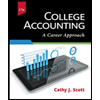
Concept explainers
(1)
Accounts receivable
Accounts receivable refers to the amounts to be received within a short period from customers upon the sale of goods and services on account. In other words, accounts receivable are amounts customers owe to the business. Accounts receivable is an asset of a business.
Bad debt expense:
Bad debt expense is an expense account. The amounts of loss incurred from extending credit to the customers are recorded as bad debt expense. In other words, the estimated uncollectible accounts receivable are known as bad debt expense.
Allowance method:
It is a method for accounting bad debt expense, where uncollectible accounts receivables are estimated and recorded at the end of particular period. Under this method,
To journalize: The September month transactions using allowance method.
(2)
Direct write-off method:
Under this method, accounts would be written off only when it is determined that the receivables from a customer remain uncollectible.
Write-off:
Write-off refers to deduction of a certain amount from accounts receivable, when it becomes uncollectible.
To journalize: The September month transactions using direct-write off method.
(3)
To Show: The amount of bad debts expense that will be reported on the income statement under each of the two methods, and describe which amount best matches expenses with revenue.
(4)
To identify: The amount that would be reported as net accounts receivable on the
Want to see the full answer?
Check out a sample textbook solution
Chapter 8 Solutions
ACC 201/202 MYACCLAB E-TEXT ONLY >I<
- General accounting questionarrow_forwardI need help with this financial accounting problem using proper accounting guidelines.arrow_forwardAlpine Motors reported: • EBITDA = $10 million Net income = $3 million . Interest expense = $1.5 million Tax rate = 30% What is depreciation and amortization?arrow_forward
- Morris Manufacturing is allocating $90,000 in inspection costs to its two suppliers using the number of inspections as the activity driver. Supplier X: 15 inspections Supplier Y: 45 inspections How much of the cost should be assigned to Supplier Y?arrow_forwardcorrect solution accounting questionarrow_forwardCrane Inc. reports: • Net Income $250 million Average Total Assets = $2,500 million What is the ROA?arrow_forward
 Financial Accounting: The Impact on Decision Make...AccountingISBN:9781305654174Author:Gary A. Porter, Curtis L. NortonPublisher:Cengage Learning
Financial Accounting: The Impact on Decision Make...AccountingISBN:9781305654174Author:Gary A. Porter, Curtis L. NortonPublisher:Cengage Learning Intermediate Accounting: Reporting And AnalysisAccountingISBN:9781337788281Author:James M. Wahlen, Jefferson P. Jones, Donald PagachPublisher:Cengage LearningPrinciples of Accounting Volume 1AccountingISBN:9781947172685Author:OpenStaxPublisher:OpenStax College
Intermediate Accounting: Reporting And AnalysisAccountingISBN:9781337788281Author:James M. Wahlen, Jefferson P. Jones, Donald PagachPublisher:Cengage LearningPrinciples of Accounting Volume 1AccountingISBN:9781947172685Author:OpenStaxPublisher:OpenStax College College Accounting, Chapters 1-27AccountingISBN:9781337794756Author:HEINTZ, James A.Publisher:Cengage Learning,
College Accounting, Chapters 1-27AccountingISBN:9781337794756Author:HEINTZ, James A.Publisher:Cengage Learning, College Accounting (Book Only): A Career ApproachAccountingISBN:9781337280570Author:Scott, Cathy J.Publisher:South-Western College Pub
College Accounting (Book Only): A Career ApproachAccountingISBN:9781337280570Author:Scott, Cathy J.Publisher:South-Western College Pub





